Tag Archives: ants
Day one – Ants, Arkansas, and Awesomeness!
What a great first day we had! Waking up at 4:30 was rough, but if it meant getting to the beautiful Crystal Paradise Ecolodge and embarking upon these amazing two weeks, it was worth it. We had a great day of travel, beginning dark and early (earlier than bright and early) at ABL, heading to IAH, then Belize City, then the 2-hour ride to the Ecolodge, with stops at Cheers Restaurant for lunch and a supermarket for last-minute supplies before heading off into the tropical rainforest tomorrow (among a swimming stop and ruins of the Mayan city Caracol, one of their largest cities!) The travel day, while exhausting, was great. I was excited to meet/ get to know everyone better, and I can’t wait for these next two EEPS with his group! We also met another class group from a University in Arkansas staying at the Ecolodge, so that was fun to meet and chat with a couple of them.
Ok, Ant-man suit on, I was skeptical of my ability to see ants today. I was wrong entirely! I saw some unidentifieable ones crawling along a pipe at the Cheers Resataurant (where we had lunch on the way to the Ecolodge from the airport.) When I couldn’t pick them out, I was discouraged, but luckily Dr. Solomon brought some tools to make identification easier when we get to Las Cuevas Research Station tomorrow for the week. At the Ecolodge, I was lucky enough to find ants on two occasions, despite being outside for not too long: first, I saw leaf cutter ants transporting their leaf cuttings to their fungal gardens (did not see their garden though 😔) and second, I saw ants making a little highway along the trail from the Ecolodge to the Macal River. I wonder if they trampled down that whole path. Both of these instances are pictured (in not so high quality) and attached below. Here’s to another day of fun, friends, and ants!
Sam Forman
2025
Off we go!
Hey hey hey! My name is Sam Forman, and I’m a rising Junior at Jones College! Some facts about me: I’m from Tampa, FL, I like to swim (good thing we’re spending a week at Glover’s!) and I am an Environmental Science major with a minor in Business!
In November, I heard about this class, applied, and made my friends apply too. In January, we were accepted. In February, we met to assign taxa and topics and introduce the course. In April, we met to look at snakes and check that our equipment worked. And now, in May, we depart for Belize tomorrow!
My expectations for this course, in truth, are limited. I expect to have fun, and beyond that I barely know what to expect. I have experience in the tropics, as I took a vacation to the Galapagos in 7th grade, but I am also fully aware that this will be about 1-5% like that trip. I also have visited the Florida Keys as part of a 6th grade school trip and done some snorkeling and marine biology exploration there, but nothing to the level of what we are going to do in this class. I know I will see things I’ve never seen before and do things I’ve never done before, and I’m excited about that. That’s pretty much all I’m expecting. I’m expecting to be wowed, the mechanism by which this will occur I cannot foresee.
A lot of this course consists of things I have generally heard about. I have heard about tropical rainforests and studied them in class, and I have extensive experience snorkeling around coral reefs. I’m excited to marry the two. The course has us learning in depth about the ecosystem through lectures and primarily through experience. I have not experienced experiential learning to this degree, so I’m quite excited about that. Accomplishments-wise, I see great potential for this course beyond tropical field biology-related educational growth. I am going to live in a rainforest with no AC and many other things I operate daily with. There will not be a Target 10 minutes away if I need anything. These two weeks will be an accomplishment in the sense that I will have lived without these things I “need.” That’s an accomplishment in and of itself. Tropical Field Biology-related foreseen accomplishments include extensive fieldwork, among others. The most fieldwork I’ve done has been in BIOS 213. Time wise, BIOS 213 Labs were probably 5-10% of the time we will spend in the field in Belize. And it will be condensed much more. I’m excited to run field experiments, (as the ant-man I have to look forward to the pee one, right?)
Pee-gets us into the “what I’m nervous about” section of the post… I’m nervous about accomplishing what I described above. It seems like it will probably be fairly difficult. The bathrooms, among other things, will likely not be similar to what I’m used to. I’m also nervous about my 3 presentations, on Ants, Wrasses, and a longer lecture on Wrasses, but that is likely the same as any pre-presentation nerves. I feel well prepared, as all of the prep work for this class has indeed felt like a full time job this past week. Between actual coursework (Taxon ID Cards, slideshows, reading) and the many shopping/ pharmacy trips, the course preparation was quite intense. Even just packing was intense, as I tried my best to finagle everything into the waterproof luggage & water-resistant backpack I have while leaving room for the helmet and sleeping bag. And, in general, I’m just jittery. So, after cautiously but hurriedly packing my bags and setting things out for myself for tomorrow (pictured below,) I’m gonna go to bed and…
…see you tomorrow for the DAY ONE RECAP!!!
<3 Sam
Is it really already over?
So…this is my course summary and wrap-up blog. I’m writing it from the comfort of my own bed after a hot shower, and yet, somehow I’d rather still be sticky, stinky, and sandy in Belize. I’m still processing everything that happened on the trip– every day was jam packed with lectures, discussions, projects, travel, fun, and new places and faces.
The transition between the ‘surf’ week and the ‘turf’ week was difficult for several reasons, but the reef and rainforest are as similar as they are different. For one thing, the soil of the rainforest is derived from limestone, which was made from the shells of ancient reef creatures. Additionally, both rainforest soils and reef waters are relatively nutrient poor, yet they support unmatched levels of biodiversity. This is possible because of the highly three-dimensional spatial heterogeneity of reefs and rainforests. Creatures adapt to specialize in a certain space and they compete for access to nutrients. This space partitioning and competition are strong drivers of diversity!
I think my favorite- most unforgettable- part of BIOS 319 was the opportunity to coexist with rare and endangered species. I’m thinking specifically of the moment when a Morelet’s Tree Frog jumped onto my hand, but I also cherish our brief sightings of Scarlet Macaws, Acropora corals, and the sounds of Howler monkeys. Recalling my pre-departure mantra of ‘enjoying every moment’, I tried very hard to not have a ‘least favorite’ part of the course. But, if I had to pick something to dislike, I would say the bugbites (although I found them quite manageable with topical benadryl and calamine lotion!)
In all honesty, I learned a lot more than I initially thought I would, and a lot of that learning came through first-hand experience! I thought my taxa (sponges and ants) were a little boring at first, but there is complexity, wonder, and value to be found in everything. I was amazed to learn that leafcutter ants account for up to 25% of devegetation in tropical rainforests and that a mature leafcutter colony has the same appetite as a cow. And I didn’t just learn about my taxa: I have never been good at birding, but now I don’t think I can ever forget the cacophonous squawks of a scarlet macaw or the iconic teardrop shape of an Oropendola nest. But I think more than any factoids about the reef or rainforest, the longest-lasting lesson I’ll be taking from BIOS 319 is confidence in myself and my abilities. I had many doubts throughout the course, but I consistently surprised myself. I doubted that I could be comfortable snorkeling and diving down in the open ocean. I doubted my ability to hold an audience’s attention and communicate effectively. I doubted my ability to hike rainforest trails or even be outside for extended periods of time… but it all came so naturally to me. Despite (or perhaps, in part, because of) my quirks and idiosyncrasies, I am incredibly adaptable and resilient in new environments and capable of facing the unknown.
Thank you to everyone (in-field and behind-the-scenes) who played a part in making this experience possible. I’m so grateful.
Speedy Hikes and a Slow Drive
Today we traced our steps along the Maya Trail to collect our pee tubes from yesterday. Some of the tubes were surprisingly difficult to find, especially the ones on the forest floor, even though we had tried to standardize their positions.
After collecting, it was time to analyze! I personally, did not collect many (any) arthropods in three of my tubes, but one of my pee tubes had a caterpillar and a roach!
Next, we had to go out to collect our camera traps! We retraced our steps from the research station to San Pastor Rd and then up and down the Bird Observation Tower. We eventually got them all, and I hope there is a good opportunity coming up to view the images together.
After a late lunch, we all piled into the van and came to the Midas Hotel in Santa Elena and San Ignacio (the twin cities). I did not see any ants today 🙁
Pee tubes, Fungus gardens, and Weird frogs
Today we started a project exploring nutrient limitations in the forest canopy and on the forest floor. We are investigating this by peeing in tubes and strapping them to different trees (I promise there is real science behind this). We are going back out on the trails tomorrow morning to collect the pee tubes and count the number of arthropods we find in them.
While we were walking the trail to place our pee traps, Phoenix spotted a jumping pit viper in the middle of the trail and then Rusty spotted an eyelash viper on a log off the trail. The eyelash viper was especially exciting, because Dr. Solomon said he had never seen one in his twelve years of visiting Chiquibul. Later on down the trail, Ava spotted what they described as a “Spiky moth” on the trunk of a tree, but when they said it was dead, I suggested that it was actually infected with the Ophiocordyceps fungus, which turns arthropods into ‘zombies.’ Almost immediately after that, I spotted another, more decomposed Ophiocordyceps moth on a leaf on the forest floor. I still really want to see an ant infected with Cordyceps, but the moth was still really cool.
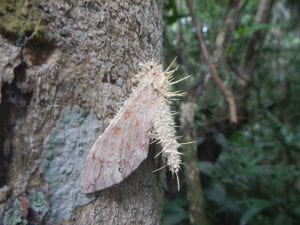
After lunch we searched nearby the research station for some leafcutter ant (Atta cephalotes) nests of differing ages to dig up and compare. First, we found a young (~1 year) ant nest with a single entrance ‘chimney’ or ‘turret’, and we started digging about a foot away to try to break into the underground fungus chambers. Dr. Solomon told us that the very young nests do not have big soldier ants for defense and that the individual worker ants are shinier than the ants in older colonies. After a few rounds of everyone taking turns digging into the nest, we finally broke into the fungus chamber, which looked like a whitish gray spongey honeycomb. Dr. Solomon started scooping out the fungus to look for the queen, and when we finally found her, I got to hold her and have my picture taken with her :’) When we tried digging up a slightly older nest, we kept digging and digging, but no ants were coming out, which made us think that the nest was abandoned. When I got my turn with the shovel, I dug down super deep and pried up a huge chunk of soil, and I exposed a Mexican Burrowing Toad (which we had learned about literally just yesterday)! We gently picked it up and it was SO gelatinous, we couldn’t believe that it could burrow into the hard packed clayey soils, but it had strong hind legs that it uses to burrow backwards!
After dinner, we went on an optional night hike to the frog pond, which was unforgettable. At the frog pond, we saw not one, but TWO endangered Morelet’s Tree Frogs. We got quite a few good pics and vids, and they even jumped and crawled on a few of us. One jumped onto my hand!!! A critically endangered species reached out and touched me! We also saw not one, two, three or four, but FIVE arboreal snakes in the branches and canopy above the frog pond hunting for the gelatinous globs of tree frog eggs plastered onto the underside of leaves. At least one was successful in getting a mouthful of frog eggs, but hopefully there are still enough for a new generation of frogs.

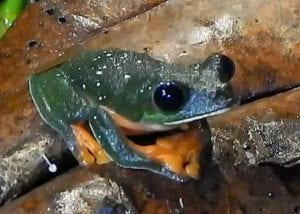
Totally psyched that we hiked
Today was our first (and hardest) full day of hiking in the rainforest! We started with an early-morning birding session fueled by coffee and awe. We heard melodious blackbirds, and saw black vultures, turkey vultures, ocellated turkeys, plumbeous kites, TWO toucans, and a collared aricari.
After a hearty breakfast, we drafted an experimental design to characterize the habitat use of predators and prey in the Chiquibul, and we suited up for a long hike to set up some camera traps.
Dr. Solomon gave me an aspirator to suck up ants into a little viewing chamber for easier identification. I didn’t get to (or need to) use it today on our hike, but it is very cool, in theory, to be like an anteater slurping up ants in the rainforest. I did see a new ant species today: the army ant (Eciton sp.)! At first, I thought it was another leafcutter (Atta cephalotes) trail, because they were moving in a straight line rather than the carpet-like swarms that are associated with the army ant species that I know of (E. burchellii), but their conspicuous reddish-color and large soldier class still identifies them as army ants.
I also saw the same type of Ponerine/Hypoponerine ant that I saw at Caracol yesterday, and this time I got some really good close up pictures, so hopefully I can consult the ant guide book and get a positive ID.
We also saw an absolutely humungous leafcutter ant nest deep in the rainforest on our hike (we set up a camera trap there, so we have an excuse to go back in a couple days). The mound was probably four feet tall and several meters in radius with dozens of entrance tunnels and ventilation shafts! Dr. Solomon said that the entire biomass of the colony was about equivalent to that of a cow, and that they probably consume about the same amount of vegetation per day.
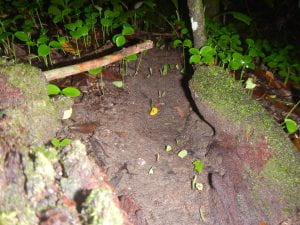
Caracol and Chiquibul
Today was chalk-full of adventure, history, and changes. We woke up early at TEC and made three field-ID’s before breakfast! First, I spotted a Shimmering Golden Sugar Ant (Camponotus sericiventris) and I told everyone that would listen to me about golden ant butts. Then, I let McKenna borrow my binoculars and she identified both a Great Kiskadee and a Social Flycatcher flitting about high up in a pine tree. Lastly, on our way into breakfast at the dining hall, we spotted an agouti (which promptly ran away from us).
We left TEC after breakfast and were on our way to Caracol Archaeological Reserve and then to Chiquibul National Forest.
Caracol was absolutely stunning. I have never visited any ancient ruins, and it was incredible to learn about the Mayan civilization and culture. The site of Caracol is vastly underappreciated and under-documented. Archaeologists have excavated several huge temples and astronomical buildings, but the entire complex is a seven mile radius with more than 35,000 individual structures (at its peak). I think the most fascinating building at the site was the ‘E-group’ astronomical building, whose three peaks align with the position of the rising sun at three key points throughout the year! As I climbed up the opposite building to see what the ancient Mayan astronomers did, it started to pour down rain (our first taste of Belize’s wet season), which made the uneven mossy steps even slipperier.
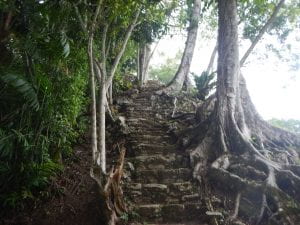
We saw some very large leafcutter ant (Atta cephalotes) colonies (more than a meter in diameter) and also a very small one! Dr. Solomon said that the small one was probably a year or two old, because it only had two entrance holes to the nest. I also saw a very large ant with mottled/spotted coloration that I didn’t recognize. I asked Dr. Solomon and he theorized that it could be a Ponerine or Hyperponerine ant.
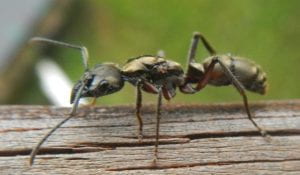
No time for Reef-flection, too much to T-E-Cee
This morning after breakfast, we had to say goodbye to Glover’s Reef (and Ruth). I had really started to get comfortable at Glover’s. The food, the views, the reefs, the hermit crabs and blue land crabs, the pelicans and frigate birds, iguanas, the snorkel shed, poster sessions, Clivus, and even the mosquito mangroves of death…. I’m grateful for it all.
After a 3.5 hour boat ride, we (quite fittingly) made our transition from ‘surf’ to ‘turf’ by dining on the shore at Calypso, a restaurant on the marina. After lunch, we all piled into two white vans and hit the road for the Tropical Education Center (TEC). On the drive, we passed a couple Police Security Checkpoints and got to see the dominant landscape features shift between developed cities, thick twisting mangroves, karstic mountains, and savannah peppered with palmettos.
At TEC, we received a lecture from Dr. Boris Arevalo, a conservation biologist who studies northern scarlet macaws. These macaws are a flagship species for several countries in Central America, so Dr. Arevalo wanted to better understand their nesting preferences on local and regional scales. The main points that I took away from his presentation was the importance of having a holistic understanding and management of BOTH breeding and foraging habitat, and that collaboration and communication are the most important tools for scientists. Some of my favorite quotes from Dr. Arevalo’s presentation:
- “Conservation is a human issue”
- “Scientists are professional beggars”
- “Conservation is a business”
After dinner at TEC, we got a night-time tour of the Belize Zoo! We saw more animals in an hour than I can recount here, but I’ll try to list as many as I can remember. We saw three types of owls (spectacled, mottled, and barn), four types of cat (puma, jaguar, ocelot, margay), coatimundis, a paca, white-lipped peccaries, a tapir (which we got to touch), a four-eyed possum, a termite nest, an anteater, and most importantly…. I finally saw leafcutter ants (Atta cephalotes)! My excitement at simply seeing their little nocturnal parades across the paths bodes well for this trip. I’ll probably fully lose my mind when I get to see their fungus gardens.
Day One: Adventure’s Just Begun!
Today was about as good of a first day as I could have hoped! Of course it wasn’t perfect- we had a few hiccups checking into the airport and an exceptionally long, but eventually we all made it to our first study site, Glover’s Reef Research Station.
After a full day of travelling (2 hours), a bus (half an hour), a plane (2.5 hours), a van (about an hour), and a boat (4 hours!), finally arriving at our home for the next week was a relief, to say the least! We gathered our luggage and settled into our rooms for a bit before being treated to a delicious dinner of chicken, salad, and rice. It’s taking all of my remaining willpower to type this blog post before I pass out from exhaustion.
At first impression, Glover’s is truly tropical paradise. Lapping waves, lush greenery, colorful bungalows, and scuttling crabs greet you as you walk from the docks. But the smiling faces and friendly attitudes of the resident researchers and crew is was really makes this oasis feel like a home-away-from-home.
My favorite part of today was during the boat ride, seeing colors that I never thought could come from water. The deepest, most intense blues of open ocean and the green and turquoise of seafood breaking on shallow offshore reefs; it was like something out of a dream. The murky browns of Galveston Bay will officially never satisfy me again!








